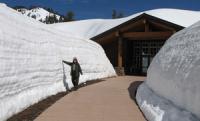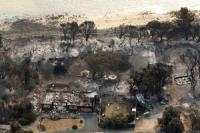-
Oroville dam danger shows how Trump could win big on infrastructure
This near catastrophe at Oroville dam — America’s tallest dam — is just the latest symptom of the chronic ill-health of America’s civil infrastructure, which has suffered from decades of under-investment and neglect. But the Oroville dam crisis could provide an unexpected opportunity for the new Trump administration to take on both problems – and win. The main problem in dealing with U.S. infrastructure is money, as up to $1 trillion would be required to repair or replace ageing dams, bridges, highways, and all the other components that support modern civilization. But there is a way for Trump to harness market forces and persuade corporate investors to invest in U.S. infrastructure. The Oroville dam near catastrophe demonstrates that some of the largest imminent threats to infrastructure will increase through climate change, and provides compelling evidence of the hard economic costs of inaction on infrastructure. If Trump moves away from climate change denial and accepts the strong balance of scientific evidence and opinion about human contribution t climate change, then a pathway to dealing with U.S. infrastructure could open up by appealing to “natural capitalism” – a market-driven economics which centers on the value of natural resources. Accepting man-made climate change could provide Trump with a chance to deliver on one of his major campaign promises, change the face of capitalism, and perhaps even save the world along the way.
-
-
Calculating climate change losses in major European coastal cities
A new study that assesses potential future climate damage to major European coastal cities has found that, if, as currently, global carbon emissions continue to track the Intergovernmental Panel on Climate Change’s worst emission scenario (RCP8.5), overall annual economic losses may range from $1.2 billion in 2030 to more than $40 billion by 2100. The study focused on nineteen major European coastal cities including Istanbul, Rotterdam, Barcelona, Hamburg, London, Dublin, Marseille, St Petersburg, and Copenhagen.
-
-
Mountain snowpack melt more slowly in a warming world

As the world warms, mountain snowpack will not only melt earlier, it will also melt more slowly, according to a new study by scientists at the National Center for Atmospheric Research (NCAR). The counterintuitive finding could have widespread implications for water supplies, ecosystem health, and flood risk.
-
-
Fewer grain dust explosions reported in U.S. in 2016
The number of grain dust explosions in the United States fell to a 10-year low in 2016, but two of the incidents resulted in the first reported fatalities since 2013, according to an annual report released by Purdue University’s Department of Agricultural and Biological Engineering. There were five grain dust explosions in 2016, compared to eight in 2015 and a 10-year average of 9.2 per year.
-
-
System automatically detects cracks in steel components of nuclear power plants
The United States operates 99 commercial nuclear power plants, which account for about 20 percent of total U.S. electricity generation. Aging can result in cracking, fatigue, embrittlement of metal components, wear, erosion, corrosion and oxidation. Researchers have developed a new automated system which detects cracks in the steel components of nuclear power plants and has been shown to be more accurate than other automated systems.
-
-
Recovery lessons from Hurricane Sandy to help improve resilience, disaster preparedness

Purdue University will lead a $2.5 million, four-year research to determine why some communities recover from natural disasters more quickly than others, an effort aimed at addressing the nation’s critical need for more resilient infrastructure and to enhance preparedness. The research team will apply advanced simulations and game-theory algorithms, access millions of social media posts and survey data collected along the New Jersey shore, which was devastated by Hurricane Sandy in 2012.
-
-
Cybersecurity of the power grid: A growing challenge
Called the “largest interconnected machine,” the U.S. electricity grid is a complex digital and physical system crucial to life and commerce in this country. Today, it is made up of more than 7,000 power plants, 55,000 substations, 160,000 miles of high-voltage transmission lines, and millions of miles of low-voltage distribution lines. This web of generators, substations, and power lines is organized into three major interconnections, operated by 66 balancing authorities and 3,000 different utilities. That’s a lot of power, and many possible vulnerabilities. The grid has been vulnerable physically for decades. Today, we are just beginning to understand the seriousness of an emerging threat to the grid’s cybersecurity.
-
-
Finding new clues for nuclear waste cleanup
Technetium-99 is a byproduct of plutonium weapons production and is considered a major U.S. challenge for environmental cleanup. At the Hanford Site nuclear complex in Washington state, there are about 2,000 pounds of the element dispersed within approximately 56 million gallons of nuclear waste in 177 storage tanks. The U.S. Department of Energy is in the process of building a waste treatment plant at Hanford to immobilize hazardous nuclear waste in glass. But researchers have been stymied because not all the technetium-99 is incorporated into the glass and volatilized gas must be recycled back into the melter system.
-
-
Identifying the right sites for storing radioactive waste
In 2008, a Swiss government agency identified six regions in Switzerland, approved by the Federal Council, which could be used to store radioactive waste. An EPFL research project has developed a detailed profile of the sites selected to store radioactive waste from Swiss nuclear power plants. The project helped identify the two sites that meet both safety and feasibility requirements.
-
-
As climate warms, Colorado River flows will keep shrinking
Warming in the twenty-first century reduced Colorado River flows by at least 0.5 million acre-feet, about the amount of water used by two million people for one year. From 2000 to 2014, the river’s flows declined to only 81 percent of the twentieth-century average, a reduction of about 2.9 million acre-feet of water per year. One acre-foot of water will serve a family of four for one year, according to the U.S. Bureau of Reclamation. From one-sixth to one-half of the twenty-first-century reduction in flow can be attributed to the higher temperatures since 2000. As temperature continues to increase with climate change, Colorado River flows will continue to decline.
-
-
Over time, nuisance flooding can cost more than extreme, infrequent events
Global climate change is being felt in many coastal communities of the United States, not always in the form of big weather disasters but as a steady drip, drip, drip of nuisance flooding. Rising sea levels will cause these smaller events to become increasingly frequent in the future, and the cumulative effect will be comparable to extreme events such as Hurricane Katrina or Superstorm Sandy.
-
-
Snow science in support of U.S. water supply
More than one-sixth of the world’s population relies on seasonal snow for water. In the western U.S., nearly three-quarters of the annual streamflow that provides the water supply arrives as spring and summer melt from the mountain snow packs. Right now, predictions of streamflow can vary widely due to limited ground measurement sites. This is one of the reasons scientists and resource managers are interested in a comprehensive view from space of what they call snow-water equivalent — the amount of liquid water contained in snow cover. Scientists use snow-water equivalent to estimate the amount of water that will melt into mountain streams, rivers and reservoirs.
-
-
Coal and oil demand to peak by 2020: Report
A boom in the popularity of solar panels and electric cars could spark irreversible changes in the energy sector within three years. By 2020, the global demand for coal and oil could peak and start to decline, according to a new report. The power and road transport sectors account for approximately half of fossil fuel consumption, so growth in the solar panel and electric vehicle markets can have a major impact on demand. The findings of this report could have serious implications for businesses and governments that supply these fossil fuels.
-
-
Sea-level rise in Southeast Asia 6,000 years ago relevant for coastal dwellers today
For the 100 million people who live within three feet of sea level in East and Southeast Asia, the news that sea level in their region fluctuated wildly more than 6,000 years ago is important, according to researchers. This is because those fluctuations occurred without the assistance of human-influenced climate change. Such a change in sea level could happen again now, on top of the rise in sea level that is already projected to result from climate change. This could be catastrophic for people living so close to the sea.
-
-
Last year’s El Niño resulted in unprecedented erosion of the Pacific coastline
Last winter’s El Niño might have felt weak to residents of Southern California, but it was in fact one of the most powerful climate events of the past 145 years. If such severe El Niño events become more common in the future as some studies suggest they might, the California coast — home to more than twenty-five million people — may become increasingly vulnerable to coastal hazards. And that’s independent of projected sea level rise.
-
More headlines
The long view
Helping Strengthen America’s Critical Infrastructure
Everyday life depends on a robust infrastructure network that provides access to running water, communications technology and electricity, among other basic necessities. The experts who keep our national infrastructure secure and resilient also need a strong network to share their knowledge and train the next generation of professionals capable of solving complex infrastructure challenges.
AI and the Future of the U.S. Electric Grid
Despite its age, the U.S. electric grid remains one of the great workhorses of modern life. Whether it can maintain that performance over the next few years may determine how well the U.S. competes in an AI-driven world.
Using Liquid Air for Grid-Scale Energy Storage
New research finds liquid air energy storage could be the lowest-cost option for ensuring a continuous power supply on a future grid dominated by carbon-free but intermittent sources of electricity.
Enhanced Geothermal Systems: A Promising Source of Round-the-Clock Energy
With its capacity to provide 24/7 power, many are warming up to the prospect of geothermal energy. Scientists are currently working to advance human-made reservoirs in Earth’s deep subsurface to stimulate the activity that exists within natural geothermal systems.
Experts Discuss Geothermal Potential
Geothermal energy harnesses the heat from within Earth—the term comes from the Greek words geo (earth) and therme (heat). It is an energy source that has the potential to power all our energy needs for billions of years.
